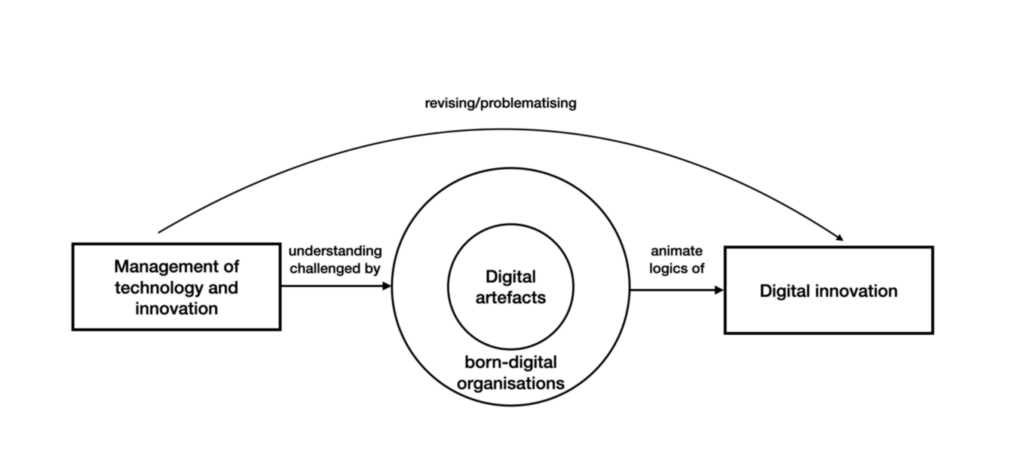Summary of my dissertation

Organizational dynamics of digital innovation
Executive summary of my dissertation with some additional pictures 🙂
My dissertation explores the organizational and managerial challenges that arise from systematic involvement of digital technologies in innovation. The work in this dissertation primarily contributes to the literature on digital innovation, which identified systematic involvement of digital technologies as an occasion to revise or problematize existing theoretical perspectives on management of technology and innovation.
Digital technologies have been theorized in the Information Systems literature as digital artefacts. Digital artefacts are objects made of algorithms and data. Digital products, profiles on social networks, databases of past transactions are all examples of digital artefacts. Digital artefacts are representative of an unusual type of materiality because they do not occupy physical space, can be duplicated and distributed freely. As a consequence, they can be arranged and recombined to achieve seemingly endless potential of configurations. The process of recombining digital artefacts is digital innovation, which this dissertation studies.

Digital artefacts are also at the centre of born-digital companies, which provide empirical focus for this dissertation. Existing research has often focused on traditional companies in their efforts to learn to effectively exploit possibilities of digital technologies. Such research provides insight into how digital innovation clashes with traditional innovation and offers insights of undeniable relevance. In contrast, the research here joins the less voluminous stream of research on born-digital organizations. With focus on born-digital organizations, we can uncover logics of digital innovation in their distilled form rather than emphasizing how they contrast or clash with organizing logics of industrial or pre-digital innovation.

The dissertation is composed of three papers: a theoretical literature review, a longitudinal case study and, a multiple case study. The first paper argues that consideration of digital artefacts is central to understanding the logic of digital innovation. This argument is developed by a means of a literature review. The theoretical literature review provides assessment of the attention given to digital artefacts in the extant literature and it constructs a research agenda. The second article presents a case study of organizing for innovation in a born-digital company, showcasing how distributable digital artefacts can stifle effectiveness of organizational separation as a vehicle for innovation. The third article investigates, by a multiple case study, how digital artefacts and organizational structures co-evolve as born-digital companies innovate their products. Overall, the dissertation proceeds from a theoretical argument to exploration of an empirical case and development of a more robust theoretical understanding of the case by moving from a single to a multiple case design.
| Paper I | Paper II | Paper III | |
| Short Title | Quest for New theoretical Logics of digital innovation | Innovation Drift | Mirroring and interpreting |
| Research question | Which properties of digital artefacts do different conceptualisation of digital artefacts uncover? | How do the specific properties of digital artefacts influence organising for innovation? | How do digital artefacts and organisational forms mutually influence each other? |
| Core concepts | conceptualisation of digital artefacts as resources, knowledge etc. | Organisational integration, separation | Mirroring hypothesis |
| Method | Literature review | Single Case Study | Multiple Case Study |
| Data | 53 papers | Interviews over 2 years | Interviews from 5 born-digital companies |
| Digital artefacts | As described in literature | Online housing market place | Five different born-digital businesses |
| Finding | Different conceptualisations emphasise different properties of digital artefacts. Research agenda proposed | Reuse of digital artefacts can cause drift of innovation from radical to incremental | Organisations mirror the socially constructed understanding of digital artefacts |
| Co-authors | Single-authored | Nikolaus Obwegeser, Sune D Muller | Single-authored |
| Status | Published at HICSS | Published at IOM | Prepared for submission to JSIS |
Empirical studies in the dissertation relate to a practical problem and hold managerial implications. The empirical problem tackled in papers II and III relates to the situation in which a company wants to develop a radical digital innovation. Is it better to develop the innovation in a new, separated group or is it better to continue development in an existing organization? Paper II highlights that focusing only on organizing can be misleading because digital artefacts can freely travel across organizational boundaries and cause drift from radical to incremental. Paper III presents a multiple case study that revisits this problem and finds out that the decision to organizationally separate an innovation effort appears to be more suitable when a new group of users with a distinct need is being targeted. Organizational separation goes hand in hand with development of separate digital artefacts because organizations and products tend to mirror one another. Overall, the dissertation first emphasizes that, when selecting organizational arrangements for innovation, handling of digital artefacts should be considered alongside organizational structures. Second, the dissertation implies that a choice to organizationally separate may be more appropriate when a new set of users with a distinct need is being targeted by the innovation.
Overall, this dissertation uncovered some organizational and associated managerial challenges that are especially salient in born-digital organizations and therefore emblematic of digital innovation. Organizationally, this research highlights the effects that digital artefacts can exert on organizational structures. They can cause drift from organizational separation to integration. They can be re-interpreted and thus interact with identities of especially born digital businesses. Such organizational phenomena are associated with new managerial challenges. First of all, the research calls for more conscious management of digital artefacts for organizing for innovation. Architectural decision regarding to reuse or new development arise as an area of concern that accompanies decisions about organizational structures. A second managerial challenge is connected to unstable identity of a digital artefacts. The identity of digital artefacts is tied to its role in consumption or to the role they play for consumers. The same digital artefacts can provide a core for a product that solves a very different need. Therefore, effective management of digital innovation requires paying attention to the changing needs that the ever- changing digital products are directed to address.